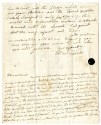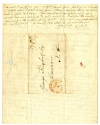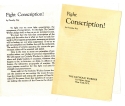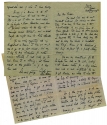In celebration of the theme of Women’s History Month 2019, this exhibition showcases twelve extraordinary women, from the collections at the Booth Family Center for Special Collections, who exemplify the nonviolent promotion of a more just and peaceful world.
Writing and Speaking for Justice
Lydia Maria Child (1802-1880)
An American abolitionist, women's and Native American rights activist, novelist, and journalist. She was one of the most influential American women writers of her time from the 1820s through the 1860s. As an advocate of women's rights, Child asserted that significant progress for women could not be made without the abolition of slavery. She believed that the subjugation suffered by women and slaves was similar. Child, along with many other female abolitionists, campaigned for equal female membership and participation in the American Anti-Slavery Society founded in 1833 by William Lloyd Garrison, Arthur Tappan, and Frederick Douglass, himself an escaped slave. The same year, Child published her book An Appeal in Favor of that Class of Americans Called Africans in which she argued in favor of the immediate emancipation of slaves without compensation to slaveholders. She is often identified as the first white woman to have written a book in support of this policy. Other significant writings include a collection of slaves’ experiences in The Freedman’s Book (1865); and Appeal for Indians (1868). Child was editor of the National Anti-Slavery Standard from 1841 until 1843.
Image: Lydia Maria Child. Autograph letter from Child and husband David Child to George Kimball, regarding their prospective expedition to Tamaulipas, Mexico, to settle a colony. Refers to plans for sugar growing in the new colony, reviving a seminary, as well as hopes of freeing the slaves in Texas and other pro-slavery states. Dated February 29, 1836. (Miscellaneous Manuscripts Collection 2, GTMGamms430, Folder 1:37)
Dorothy Day (1897-1980)
Activist for social justice and a journalist who expressed her beliefs in much of her writing. In 1917, Day was imprisoned as a member of suffragist Alice Paul's nonviolent Silent Sentinels. Throughout the 1930s, she worked closely with fellow activist Peter Maurin to establish the pacifist Catholic Worker Movement, which provides direct aid to the poor and homeless, as well as practicing nonviolent advocacy. Day also engaged in civil disobedience, which led to her arrests in 1955 1957, and 1973 at the age of seventy-five.
As part of the Catholic Worker Movement, Day co-founded the Catholic Worker newspaper in 1933, and served as its editor until her death in 1980. Through the paper, Day propounded the Catholic economic theory of distributism, which she considered a third option to capitalism and socialism.
Image 1: Dorothy Day. Photograph. Undated. (Gallery of Living Catholic Authors, GTMGamms472, Folder 13:41)
Image 2: Dorothy Day. Fight Conscription! Flyer published by The Catholic Worker. Undated. (Gallery of Living Catholic Authors, GTMGamms472, Folder 13:42)
Dorothy Thompson (1893-1961)
Noted by Time magazine, in 1939, as one of the most influential women in America. Thompson was the first American journalist to be expelled from Nazi Germany in 1934 for her book I Saw Hitler (1932), which was expanded from an interview she conducted in 1931. Throughout the war years, Thompson continued to protest against Nazism, especially the activities of the pro-Nazi German-American Bund. After graduating from Syracuse University in 1914, where she studied economics and politics, Thompson traveled to Europe and became involved with a Zionist group. Her first assignment as a journalist was to report on the group’s meetings for the International News Service. From 1925 to 1927, she was chief of the Central European Service for the Philadelphia Public Ledger in Vienna. In 1936, Thompson became the second female network news commentator when she was hired by NBC radio. The other was Kathryn Cravens for CBS. Thompson remained with NBC until 1938. She was commentator for the Mutual Network in 1941, and the Blue Network from 1942 to 1945. For twenty-four years, Thompson also wrote a monthly article for the Ladies Home Journal on topics such as art, children, and gardening.
Image: Dorothy Thompson. Letter to Francis Talbot, S.J., editor of America magazine. Dated March 24, 1939.
…I am profoundly pessimistic – over the short run at least – over Europe as I see it. Nazi Germany already dominates the continent and all countries live now by her grace. And Nazism I do know, thoroughly. I think its tenets are incompatible with everything Christian, and with every conception – ethical, political and cultural, associated with civilization. (America Magazine Archives, GTM.Gamms60, Folder 21:22)
Susan B. Anthony (1820-1906)
Raised in the Quaker tradition and engendered by her parents with a sense of independence and social justice, Anthony was collecting anti-slavery petitions at the age of 17. She became the New York state agent for the American Anti-Slavery Society in 1856. Anthony was acquainted with the leading abolitionists of her time including William Henry Channing, Frederick Douglass, William Lloyd Garrison, Wendell Philips, and Parker Pillsbury. In 1851, she met fellow woman suffragist Elizabeth Cady Stanton. Together they formed the New York Women's State Temperance Society (1852), after Anthony was prevented from speaking at a temperance meeting due to her gender. In 1863, Anthony and Stanton founded the Women's Loyal National League, which conducted the largest petition in U.S. history at the time, collecting nearly 400,000 signatures in support of the abolition of slavery. In 1866, they established the American Equal Rights Association, which campaigned for equal rights for both women and African Americans.
In 1869, Anthony and Stanton founded the National Woman Suffrage Association, later renamed the National American Woman Suffrage Association after merging with the American Woman Suffrage Association. Anthony’s arrest in 1872, for voting as a woman in her hometown of Rochester, N.Y., led to her widely publicized trial; a fine that she refused to pay; and ultimately a grant by Congress, in 1878, for an amendment giving women the right to vote. Introduced by Aaron A. Sargent (R-CA), the amendment (also known as the Susan B. Anthony Amendment), was ratified as the 19th Amendment to the U.S. Constitution in 1920.
Anthony traveled and lectured extensively on women’s rights. Her work included a key role in the development of the International Council of Women; as well as the World's Congress of Representative Women at the World's Columbian Exposition in Chicago in 1893.
Initially ridiculed and criticized, Anthony has become known as the "Napoleon of feminism" and is remembered today as one of the most historically significant advocates of women’s rights. She is the first woman to be depicted on U.S. currency, appearing on the dollar coin in 1979. In 2016, hundreds of women voters attended her gravesite to honor her achievements and celebrate Hillary Clinton as the first woman in American history to be nominated as presidential candidate for a major political party.
Image: Susan B. Anthony. Photograph. Signed and inscribed “Affectionately yours”. Undated. (Janet Richards papers, GTM540129, Folder 9:1)
Art for Peace
Violet Oakley (1874-1961)
American painter, illustrator, muralist, and stained glass designer. Oakley was the first American woman to receive a public mural commission, and is best known for the series of murals she completed for the Pennsylvania State Capitol, as well as her Renaissance-revival style of art influenced by the Pre-Raphaelites. Other significant works include murals, panels, and stained glass commissions completed for the Vassar College Alumni House, Charlton Yarnall House (Philadelphia), and Cuyahoga County Courthouse.
Oakley's political beliefs were shaped by William Penn (1644-1718), whose ideals she represented in her murals at the Pennsylvania State Capitol and in her book The Holy Experiment: A Message to the World from Pennsylvania (1922). She was committed to the Quaker principles of pacifism, equality of the races and sexes, economic and social justice, and international government. When the United States refused to join the League of Nations after World War I, Oakley traveled to Geneva, Switzerland, where she spent three years drawing portraits of the League's delegates, later published as Law Triumphant: the Opening of the Book of the Law and the Miracle of Geneva (Philadelphia, 1932). She was also an early advocate of nuclear disarmament after World War II.
The first woman elected to the National Society of Mural Painters, Oakley received the Gold Medal of Honor of the Pennsylvania Academy of Fine Arts, and was the first woman awarded the Gold Medal of Honor from the Architectural League of New York. In 1977, her studio in Philadelphia was listed on the National Register of Historic Places in recognition of her artistry.
Image: Violet Oakley. The Book of the Pageant. Cover design by Violet Oakley. Printed program for a city event celebrating Philadelphia, held on October 9, 1908: “...much of great interest and value to the state, the nation and the world was enacted in Philadelphia. The achievements of peace of the city have been at all times conspicuous. In literature and art, in science and medicine, in solving the problems of transportation and in other practical fields of civilization, Philadelphia, among American cities, owns no superior, and all these things it has been a pleasure to attempt to illustrate in the form of a pageant in the streets.”
Josephine Baker (1906-1975)
American-born French entertainer, activist, and French Resistance agent. Baker resided and made her career in France and Europe. Early on, Baker was among the most celebrated performers of the Folies Bergère in Paris. In 1927, she caused a sensation by appearing in a costume consisting of only a girdle of artificial bananas when performing in the revue Un Vent de Folie. Her image in this costume would become an icon of the Jazz Age. Baker was the first person of color to earn international renown and to star in a major motion picture Zouzou directed by Marc Allégret, in 1934. Baker refused to perform for segregated audiences in the United States and is noted for her contributions to the Civil Rights Movement. In 1968 she was offered unofficial leadership of the movement in the U.S., by Coretta Scott King, following the assassination of Martin Luther King, Jr. However, Baker declined in order to protect her children. Baker was a recipient of the French Croix de Guerre for aiding the French Resistance during World War II, and was named Chevalier of the Legion of Honour by General Charles de Gaulle.
Image: Josephine Baker. Letter by Josephine Baker referring to racial issues in America. Dated 26 August, 1947. (John L. Brown papers 2, GTMGamms205, Folder 1:7)
Peace through Diplomacy and Cultural Understanding
Gertrude Bell (1868-1926)
British travel writer, archaeologist, explorer, and ex officio diplomat. Bell traveled extensively, twice circling the globe, mountain climbing in Switzerland, and visiting India. Facile in languages including French, German, Italian, Farsi and Turkish, she also learned Arabic in Jerusalem and studied Byzantine, Egyptian, Greek, and Roman art and archaeology.
In 1913, Bell made her final expedition across the Arabian Desert (now northern Saudi Arabia), withstanding numerous raids and brief imprisonment in Hayil. During World War I, Bell’s insight into the region’s tribal relations acquired during her travels proved invaluable to the British government in securing Arab support against the Turks who were allied with Germany. With the support of T.E. Lawrence (well-known as Lawrence of Arabia), Bell became liaison between the British government offices in Delhi and Cairo providing both with information she garnered from Arab sources.
After the war ended, Bell’s knowledge of the land and people of Persia (Iran), Syria, Kuwait and the Mesopotamian region, was again sought by the British government to assist with drafting territorial boundaries for Iraq. Ultimately, Bell recommended that there should be an Arab head of state in Iraq, rather than a British protectorate. It was largely due to her efforts that Faisal was crowned king in 1921. In addition to advising Faisal, Bell spent her remaining years as founder and director of the Iraq Museum of Antiquities.
Image 1: Gertrude Bell. Letter written from Baghdad to Cornelius Van Engert, Second Secretary to the U.S. Legation in Teheran, reporting on the political situation in Mesopotamia. Bell was appointed by the British government to act as mediator between British and Arab interests in the region. Dated September 25, 1921.
We have a hard six months work before us, the Assembling of the Congress, the passing of a reasonable organic law, and the framing of a workable treaty between the two Governments – one which will allow us to give the Arabs a very free hand and yet enable us to fulfill our international obligations, that is how I should define workable – and then I think we may feel that the foundations are firmly established with promise of endurance… (Cornelius Van Engert Papers, GTM.970901, Folder 1:10)
Image 2: Gertrude Bell. Letter to Cornelius Van Engert, on stationery of the Office of the High Commissioner, Baghdad. Circa April 1921. (Cornelius Van Engert papers 2, GTM970901, Folder 1.9)
Katherine Biddle (1890-1977)
American poet, and patron of African American writers and artists, including eminent leaders of the Harlem Renaissance, Langston Hughes (1901-1967) and Alain Locke (1885-1954). A staunch advocate of civil rights, Katherine Biddle's best-known poems on the issue include, "And They Lynched Him from a Tree," "Plain Chant for America," and a play about African-American abolitionist Sojourner Truth (1797-1883).
Image 1: Biddle Katherine. Photograph. Original framed and inscribed to Mrs. Wainright (possibly Carol Wainright, Biddle's attorney). Undated. (Miscellaneous Manuscripts collection 2 Gamms430, Folder 1:17)
Image 2: Alain Locke. Letter to Katherine Biddle encouraging her to submit the script of her play “Sojourner Truth” to film producer Walter Wanger for a movie adaptation. (Katherine Biddle papers, GTMGamms250, Folder 51:26)
Anna Gurvin (1932-2008)
Gurvin joined the U.S. Information Agency (USIA) as assistant cultural affairs officer in Montevideo, Uruguay, where she served until 1970. From 1972 to 1973, she was assistant cultural affairs officer in Buenos Aires, Argentina. An important aspect of Gurvin’s career was the promotion of internationally collaborative programs for arts and education. Gurvin was born in Minnesota, taught English and became a librarian before entering Federal employment.
Image: Anna Gurvin. "Fulbright and the Arts: Strategies for the 90s.” Speech given at the Fulbright Association Annual Conference, George Washington University, October 1989. (Anna Gurvin papers GTM161110, Folder 12:6)
Justice through Humanitarianism
Barbara Ward (Baroness Jackson) (1914-1981)
A leading economist and dedicated humanitarian whose tireless efforts to foster a system of international cooperation for solving worldwide economic and environmental problems were aided by her powerful and persuasive books. In 1950, Ward married Sir Robert Gillman Jackson, an Australian working for the United Nations, and moved with him to the Gold Coast (Ghana). Ward was appointed president of the International Institute for Environment and Development, in 1973, a position that afforded her an active role in almost every United Nations conference on global issues in the 1970s.
Ward was presented the title of Dame Commander of the Most Honourable Order of the British Empire (D.B.E.) in 1974, and was named a Life Peer, receiving the title Baroness Jackson of Lodsworth, in 1976. The latter entitled Ward to a seat in the House of Lords, thus expanding her impressive political influence as an informal advisor to eminent world figures including Willy Brandt, Indira Gandhi, and Pierre Trudeau, as well as U.S. presidents John F. Kennedy, Lyndon B. Johnson, and Jimmy Carter. Ward’s papers at Georgetown University Library include manuscripts for her principal works: Only One Earth (1972), The Home of Man (1976), and Progress for a Small Planet (1979).
Image 1: Indira Gandhi. Letter to Barbara Ward regarding the latter's proposal to nominate Mother Teresa for a Nobel Peace Prize. Dated March 20, 1975. (Barbara Ward papers GTMGamms211, Folder 2:42)
Image 2-3: Barbara Ward. The Home of Man (1976). Manuscripts for Chapter 7 “Is the Future Possible?” (Barbara Ward papers, GTMGamms211, Folder 4:37)
Rose Hawthorne Lathrop (1851-1926)
Philanthropist and writer, Lathrop was the youngest daughter of American author Nathaniel Hawthorne. Lathrop founded a home for victims of incurable cancer in 1896, and formed a religious sisterhood known as the Servants of Relief for Incurable Cancer, taking the name of Sister Alphonsa. Her work was initially established at the Rosary Hill Home in Hawthorne, New York, in 1901, expanding to a second location at St. Rose’s in New York City in 1912.
Lathrop’s writings include a series of reminiscences about her father, Memories of Hawthorne (1897), and a history of the Georgetown Visitation Convent, A Story of Courage (1894), co-authored with her husband George Parsons Lathrop.
Image: Rose Hawthorne Lathrop. "Of My Life." Pages from the manuscript of her autobiography. Undated. (Theodore Maynard Papers GTMGamms329, Folder 2:7)
Eleanor Roosevelt (1884-1962)
Eleanor Roosevelt was a controversial First Lady in her time for being outspoken and extraordinarily active on social justice issues. At times, she publicly disagreed with the policies of her husband Franklin Delano Roosevelt. Her advocacy for the rights of African Americans, women, youth, and the poor helped to direct government focus onto constituents that were marginalized by legislative and political processes.
The first presidential spouse to hold regular press conferences, Eleanor Roosevelt paved the way for women journalists and compelled news services to employ women in order to ensure representation during news events. She also wrote newspaper and magazine columns, hosted a weekly radio show, and further broke tradition when she addressed the National Democratic Party conventions in 1952 and 1956.
Following her husband's death in 1945, Eleanor Roosevelt remained active in politics for the remaining 17 years of her life. She pressed the United States to join the United Nations and became its first delegate. She served as the first chair of the United Nations Commission on Human Rights, and oversaw the drafting of the Universal Declaration of Human Rights (1948). In 1961 she became chair of the President’s Commission on the Status of Women established by John F. Kennedy. To this day, Eleanor Roosevelt is one of the most highly regarded women in the world.
Image: Eleanor Roosevelt. Signed photograph. Undated. (Miscellaneous Manuscripts collection 1, Gamms345, Folder 18:11)
Curated by Lisette Matano, Manuscripts Archivist



















